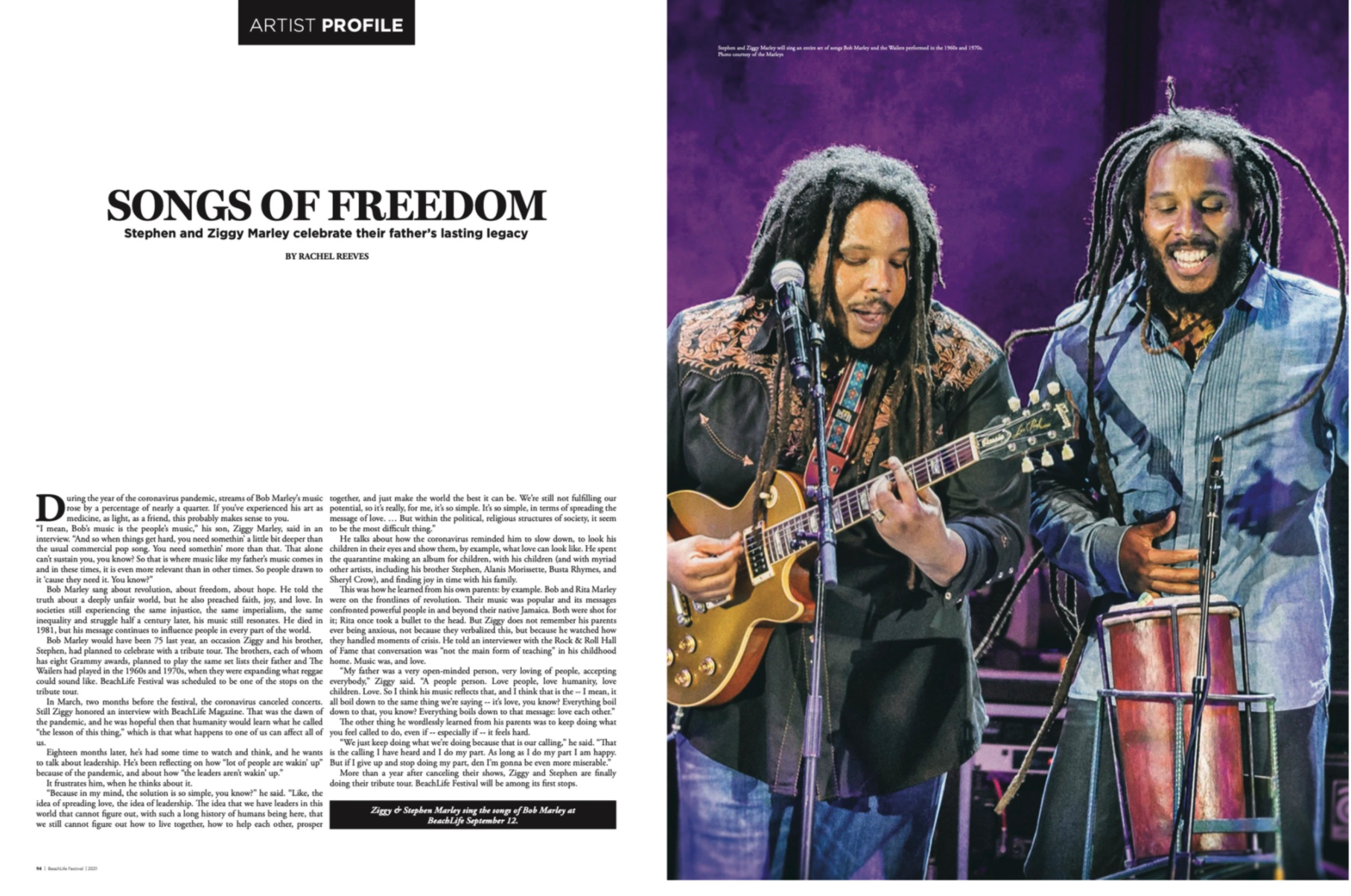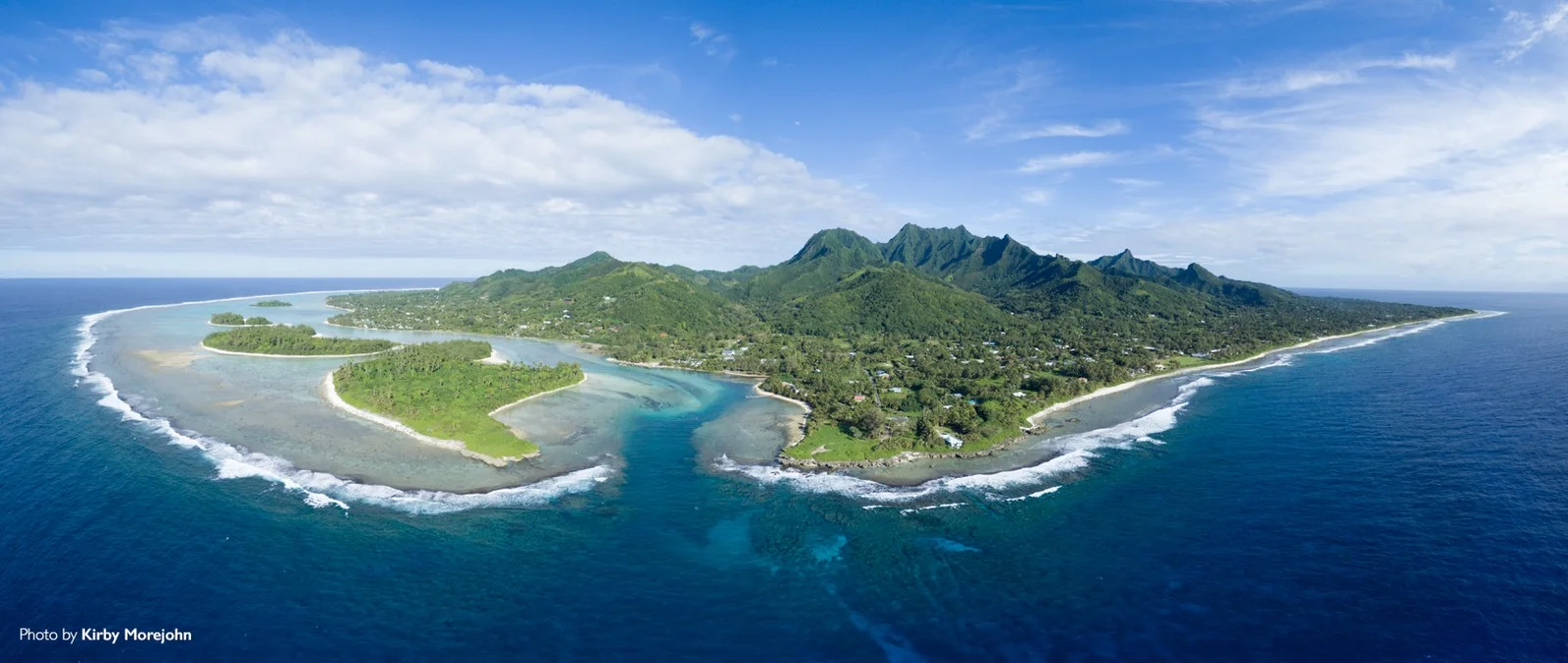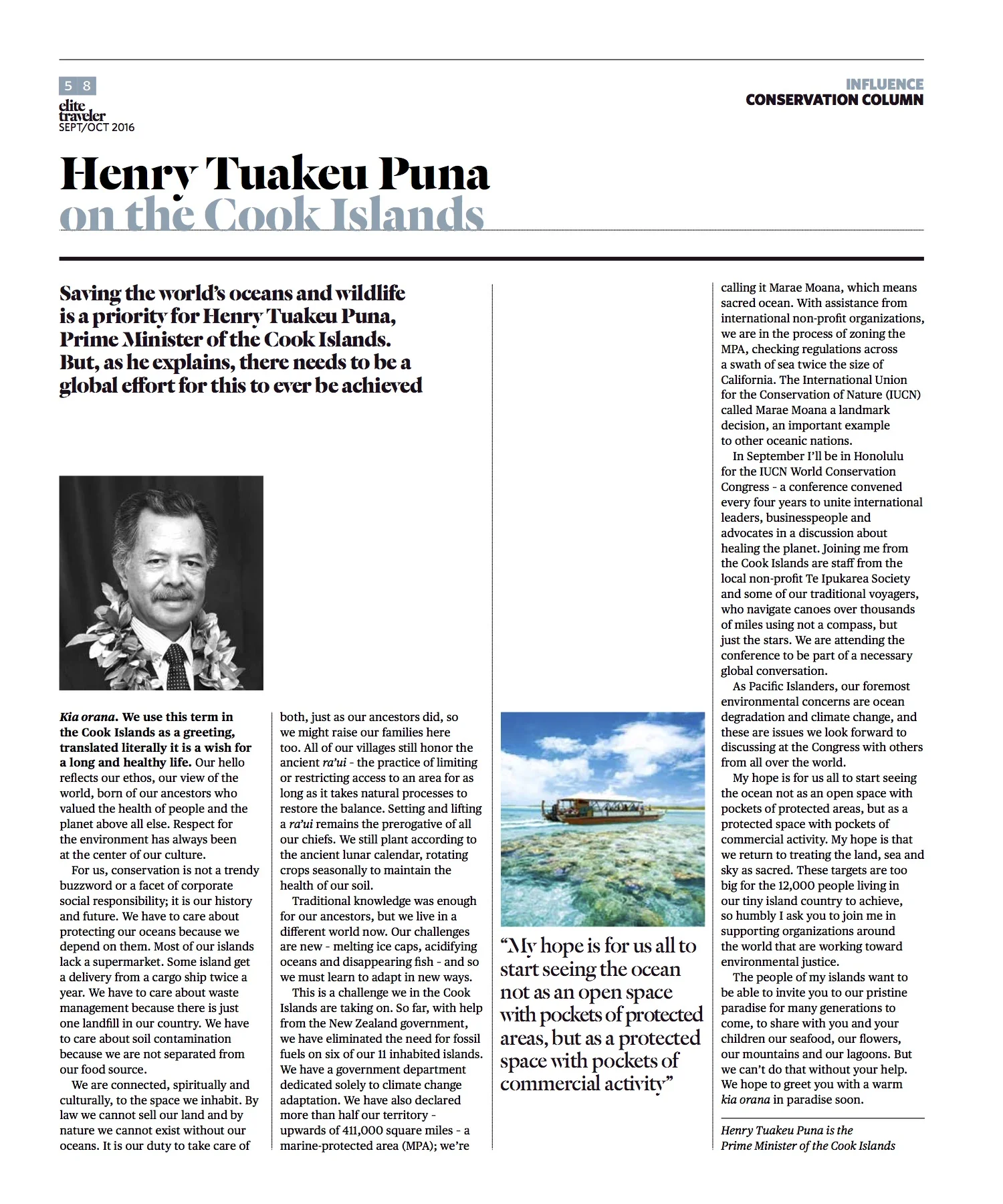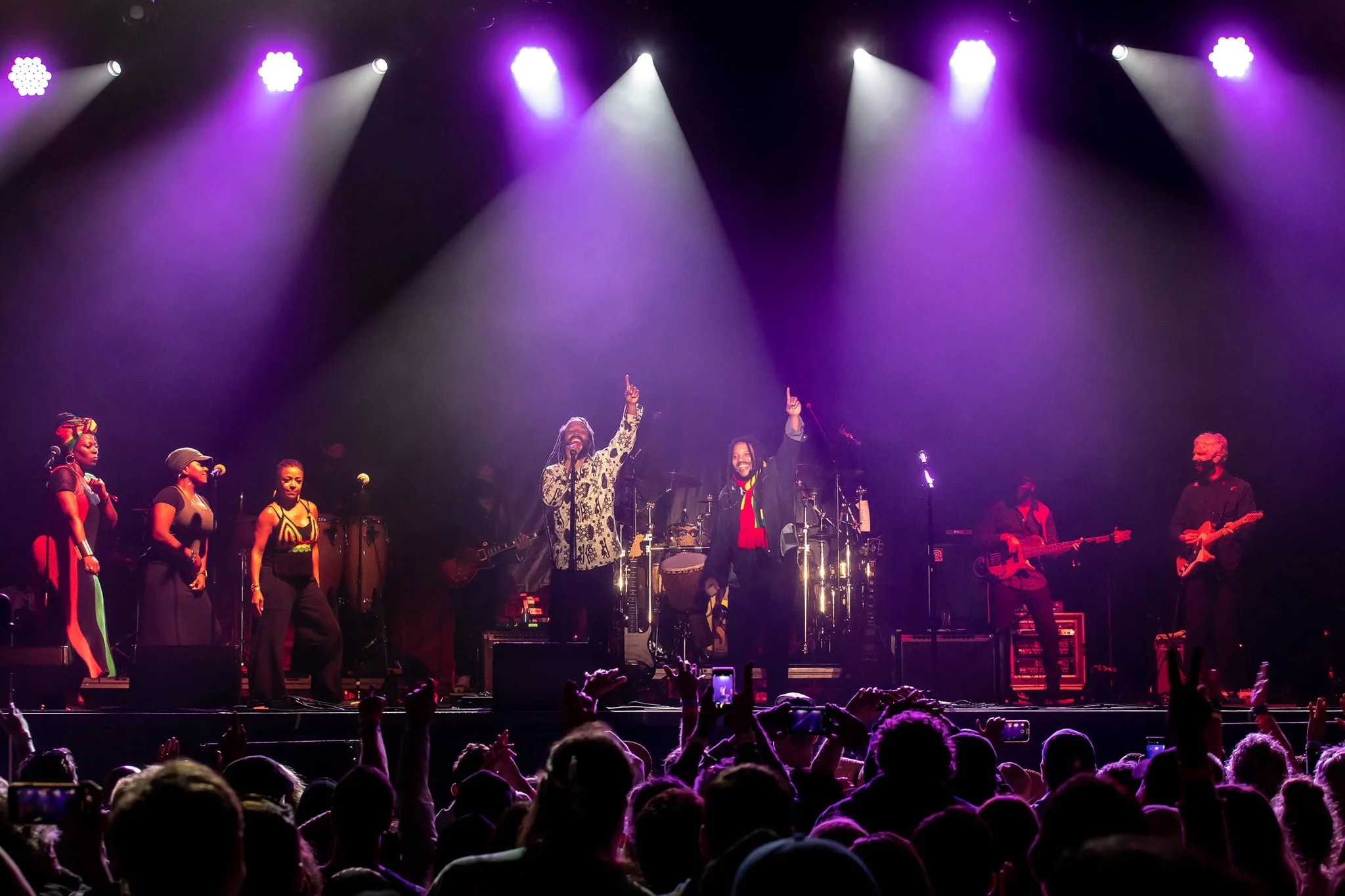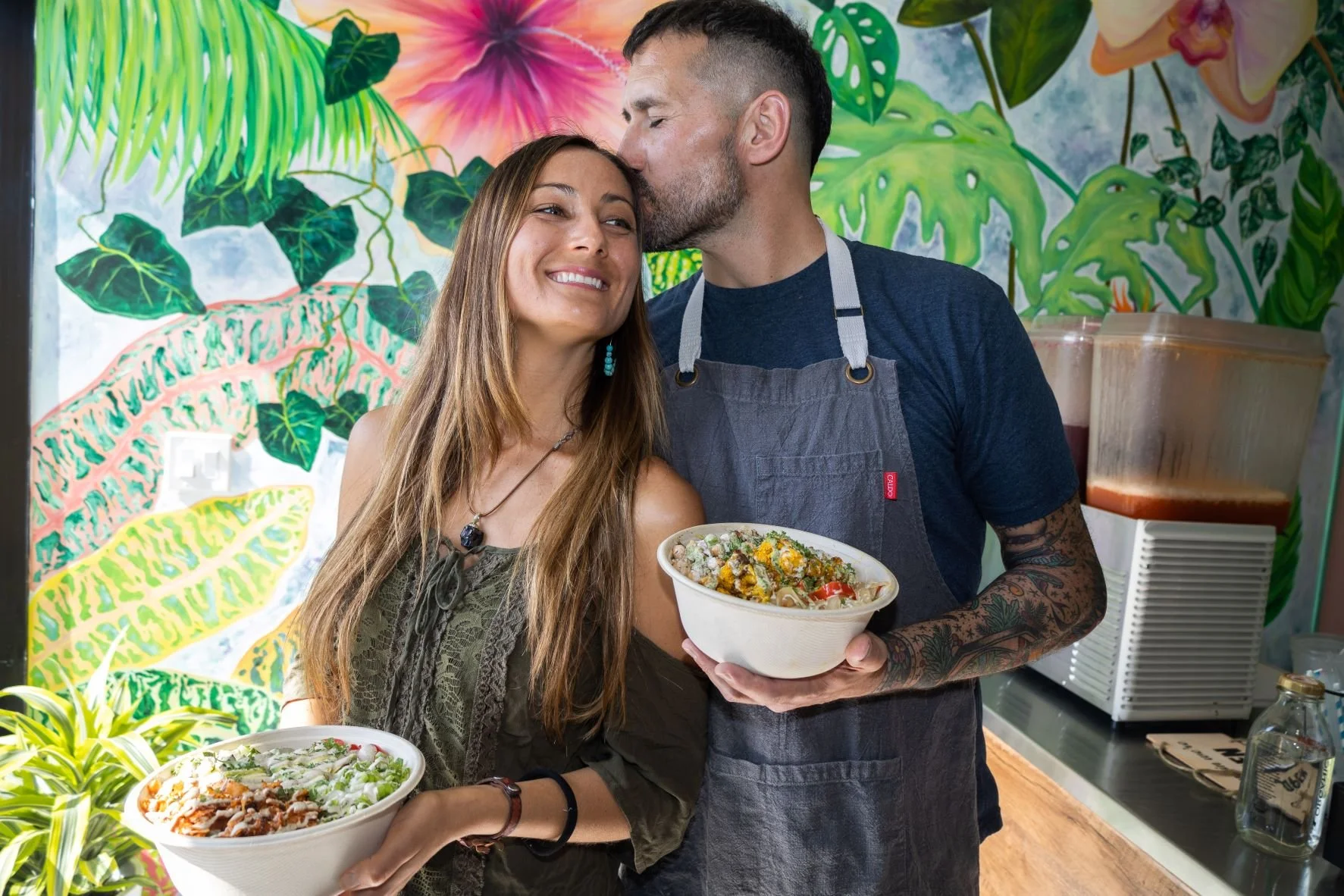The tourist trap
Appeared in New Zealand Geographic
Watched by a group of tourists in togs, Ravenga “Rav” Teau drags his index finger through the white sand. He sketches the Avaavaroa Passage—a break in the reef that rings Rarotonga and divides its see-through lagoon from the deep-blue ocean. The passage, about a kilometre from the shore, is a portal to the currents and creatures of the open sea. It’s a dangerous spot, but a favourite hangout of turtles, rays and fish—and, more recently, tourists like these, many of whom are new to snorkelling.
“Most locals haven’t even done this,” Teau tells his charges. “Kids here get told to stay out of the passages. They really tried with us.” He laughs, nodding to his childhood friends standing nearby. As kids, these men lived to surf and to spear fish in this passage. Now they are trained lifeguards, paid to show people around it. This month, their group, Go Local Cook Islands, will be running five tours daily, alongside 11 other operators who have gravitated to this passage in the last few years. There are increasing concerns about what impact so many snorkellers might be having on the biodiversity of this spot—and for their safety.
Don’t struggle against the current, Teau tells today’s group. Cruise with it, like Crush, the stoned turtle from the Disney movie Finding Nemo. Let the turtles come up for air. Don’t touch them. Don’t stand on the reef; it’s alive, and it takes years to regrow after it’s damaged. The currents change fast. Follow our lead.
He picks up a bush knife, explaining it’s every Cook Islands child’s second toy. “Once you master the rake over here, you get a machete,” he says. He cracks a coconut with a single swing, smiles, and offers its two halves to a tourist to drink.
This is August, the height of the busiest season on Rarotonga. A wind that locals consider chilly is blowing across the beach—it’s 24 degrees, perfectly balmy if you’re escaping a New Zealand winter, like two-thirds of the tourists here.
Teau and the other members of Go Local’s core staff moved home to Rarotonga in their early 30s from Australia, where they had worked in construction and mining, to show tourists around the ocean where they spent some of their most joyous moments. Here, on the unpeopled beach of Rarotonga’s south shore, Teau’s bout with leukaemia and the bustle of motorways and a corporate routine feel a world away.
“We get paid to just be ourselves,” says Donald Hallin, the dreadlocked father of three girls. He co-founded the business in 2019, the country’s highwater mark for tourism. There is an unusual ease to this industry in the Cook Islands: anyone can participate, from the kids selling husked coconuts on the side of the road during school holidays to the landowners who rent out lagoonside studios.
“One of our key philosophies here at the office is to remove or limit all barriers of entry for Cook Islanders to be a part of tourism,” says Karla Eggelton, who is the first Cook Islander to run the tourism bureau since the 1990s. “And that’s really important.”
Unlike the outer islands, where most people survive by farming and fishing, Rarotonga and its much-less-populated neighbouring island, Aitutaki, are in the business of accommodating tourists, particularly the ones seeking “authentic” experiences. Hospitality contributes two-thirds of the country’s GDP. The islands teem with entrepreneurs: wedding planners, tour guides, photographers, Airbnb hosts.
Beneath the shade of the coconut frond-fringed hut he works out of, I chat with Ngametua Mamanu, who’s known for his toothpaste-ad smile and wearing traditional garb about town. He tells me he went from earning $6.50 an hour working the reception desk at Crown Beach Resort to teaching groups of tourists what he learnt growing up—which leaves are medicinal, how to grate a coconut, what to cook in an underground oven—for NZ$95 per person.
Cook Islanders inherit land by virtue of genealogy, and even that is now pivoting to tourism: instead of living on their land or farming it, many locals build holiday homes to rent out. At last count, as well as 80-odd hotels and backpackers’ on the islands, there were 572 holiday homes.
“If you really think about it, pretty much everyone is in tourism,” says Tina Kae, who plants taro with her dad and three kids when she’s not working at the tourism bureau. Even pastors participate; from the pulpits of limestone churches, they warmly welcome and bless the tourists inevitably seated in the back.
Cook Islanders have always known hospitality; it is built into the heritage of island people to be welcoming. But the first inklings of a tourism industry appeared in the early 1900s when the Cook Islands Tourism Authority, a colonial outfit, began marketing Rarotonga as “New Zealand’s ideal winter resort” to wealthy Kiwis booking rooms on steamships headed to the US.
In 1969, when my grandma’s late husband took out a loan to build the country’s first motel, people laughed at him. The Cook Islands was fresh into self-governance and the idea that enough visitors would come to keep a motel running seemed absurd. In 1974, though, the New Zealand government funded an upgrade of the airport to accommodate long-haul aircraft, thus opening the door to tourists in pursuit of paradise.
Albert Henry, the country’s leader at the time, worried about unintended consequences.
“An expression that is spoken quite openly in the Cook Islands is that when you open the door,” he said in a 1970 radio interview, “the wind is bound to blow in all sorts of leaves.”
By 1980, more than 400 international flights were landing in Rarotonga every year. And thousands of Cook Islanders, who were and are New Zealand citizens, were flying out, headed for jobs in cities overseas. In the span of 40 years, the number of Cook Islands Māori still living in their islands dropped by more than a third, from around 20,000 to 13,000. Meanwhile, tourism steadily increased, becoming a welcome and largely celebrated boon. By 2012, it was earning roughly 40 per cent of GDP.
Nine years ago, some of tourism’s “unwanted leaves” settled in the clear waters of Muri Lagoon.
You can lap Rarotonga in about 40 minutes, trundling along the ring road that follows the coast. The international airport is at the northern end of the island; Muri, a once-sleepy village, is almost directly opposite. When my dad was growing up in Muri in the 1960s and 70s, his friends from school didn’t come over because he lived too far away, out in “the country”. But tourists were attracted to Muri’s shallow, still, warm lagoon, sheltered by three pristine islets. Over time, despite the warnings of scientists concerned about what development would do to the foreshore, a seawall of cafes, restaurants, rental houses, and hotels sprouted along the beach.
In the spring of 2015, black, foul-smelling algae began darkening the water lapping at Muri’s beach. My grandma, who harvested seafood from the reef with her friends as a young girl, talked about it daily. The cabinet declared a national emergency. A team of consultants concluded that the bloom was most likely triggered by the overloaded wastewater system. No reticulated—connected—system existed, and individual septic tanks, installed in the era before stringent standards, were beginning to crack and leach through the free-draining coral sand. The government commissioned some large-scale studies involving dye tracing, drilling, and drones to identify bad tanks and design solutions. That data collection continues today. So do the algal blooms, on and off. (A few summers ago, the bloom was so extensive that as the algae decomposed, and oxygen levels dropped, fish, sea cucumbers and other creatures washed up dead on the shore.)
Through it all, the tourists came. In 2019, nearly 176,000 people visited the Cook Islands, more than 10 times the country’s population and more than any previous year. GDP hit $575.4 million, of which the majority came from tourism—more than agriculture, fishing, manufacturing, taxes, and offshore banking combined.
The income moved the Cook Islands into the “developed country” category that the Organisation for Economic Cooperation and Development uses to determine eligibility for aid.
“Pre-COVID, tourism was very much a growth strategy,” Eggelton, the tourism bureau’s CEO, says. The growth had surpassed everyone’s expectations. “You could say that we were bursting at the seams.”
When the Cook Islands closed its borders on 24 March 2020, the community entered a strange new season. Without tourists, the country was “haemorrhaging, from an economic perspective”, as Eggelton puts it. A few residents had mental health crises. Many boarded “repatriation” flights to New Zealand, organised to collect Cook Islanders stuck there, and stayed, finding work in factories, packing meat, or picking fruit. (It’s estimated that almost 3000 residents flew out, leaving about 14,800 in the islands by June 2023.)
Many of those who stayed recall it as a happier, simpler time.
“Or maybe that was just the poor people,” says Sam Ataera, a builder for whom work never slowed down. “The poor people seemed happier.” When the tourists stopped coming, people returned to farming, fishing, and sharing.
The old people say that when the borders closed, the land came alive again.
Land in the Cook Islands is a birthright. Acreage can be leased to foreigners for up to 60 years, but never sold. Families have access, as a result, to fertile plots that readily grow fruit, vegetables, herbs, coconuts, and root crops. Everyone knows a farmer: more than two-thirds of households have their hands in the dirt, growing flowers for garlands or food. Fishing is also a birthright; many islanders grow up spearfishing for parrotfish or pulling octopuses off rocks. So when the borders closed, the ancient, enduring, not-quite-extinct system of bartering gained new life. People used Facebook to swap produce and fish. Locals taught tourists who were stranded in paradise how to make coconut cream and catch fish when their money ran out.
Traffic disappeared. Rates at hotels plummeted, so locals went on “staycations” for the first time. The price of tuna dropped from $30 to $4 per kilo. The drop was a quirk of demand—no tourists ordering ika mata, raw fish in coconut milk—but also supply.
Joachim Tau fishes primarily in a traditional style, by throwing a harpoon and staying with his prey until the fight goes out of it. When the borders closed, he said, he saw something he’d never seen before: enormous schools of young tuna.
“We had so much tuna we didn’t know what to do with it,” Tau recalls. Whether a result of supply or just a drop in demand, there was suddenly enough to give away. The old fishers, the ones in their 70s, say that’s how it used to be.
“It was the best time,” says Tau’s wife, Kim, who’s nursing two-year-old Kumuhei at Avana, the beach from which the voyagers who discovered New Zealand departed centuries ago. “We weren’t selling as much as we did before but we learnt how to live with less.”
For many, income decreased and quality of life increased.
“I think we needed a reset like that,” says Ana Maine, as she twists a tuning peg made of pearl shell into a freshly carved ukulele. Maine grew up dancing, Cook Islands style, for tourists in Queenstown, then moved as an adult to Rarotonga. Now she times her day by the sun, and her two boys spend their days making mud pies with the neighbours’ kids (see profile, page 26).
Before COVID, Maine and her partner, Maurai Villa, both musicians, were making as many as 20 ukuleles a week in the iron-roofed workshop beside their home. They spent thousands of dollars per month on imported timber from the local building supply store. The popularity of their business, which they inherited from Villa’s family, kept them running at a rat-race pace.
“We were so busy,” Maine says. “And then when COVID happened, we thought, what if there’s no more tourism, ever again? It made us really change the way we think.”
They decided to curb quantity and focus on quality. They now source, dry, strip, and treat local wood. Maine knows where all the wood in the workshop came from: the slab against the wall is from the island of Mangaia, transported to Rarotonga in her dad’s luggage; behind the bench is a 20-year-old tree from a garden in Titikaveka; propped against the door is mango from the village. The process takes longer—one ukulele every few days compared to two a day—but now it feels less like a production line and more like a passion.
As she works, Maine is thinking about the musician who will own the ukulele and the home it will bring joy into. She knows this joy. During our interview, she strums the lullaby she sings to her boys every night. “I am seeking,” she sings, in Tahitian, “the path to the breath that gives life.”
When the borders were closed, Eggelton, the tourism bureau’s CEO, heard a lot of talk about tourism.
“People were coming out and saying, ‘Hang on. Actually, we like having our country back to ourselves’,” she recalls.
The bureau used the downtime to design a new strategy. It would target “responsible” tourists and encourage “regenerative travel”—tourism that not only does no harm, but helps. (The strategy also zeroes in on tourists who spend more and stay longer.) Already an optional certification programme existed; businesses could opt in to be certified as mana tiaki, loosely translated as honourable guardians. Now, tourists would be directed toward organisations doing work in the community: walking dogs, planting trees, cleaning coral.
The bureau also changed its tagline from “love a little paradise” to “love our little paradise”—the pronoun is meant to implicate visitors as well as residents in the work of caring for these islands. The new strategy document acknowledges that before COVID, Rarotonga had been edging “dangerously close to (or past)” what it calls “over-tourism”. Left to its own devices, tourism is like the free market: when it’s fed, its appetite gets bigger. Like governments around the world, which have recently begun imposing fees for tourists and outlawing short-term rentals, the Cook Islands government was recognising that strategic shifts can help keep those appetites in check.
“We just haven’t done enough,” Eggelton says.
The borders reopened in January 2022 and the following year, 143,506 visitors came and went. Eleven thousand of those arrived on cruise ships that called into port on sleepy Sundays, when most locals were at church or napping.
This winter, what locals keep saying is: the island feels busy. A drive that used to take 15 minutes now takes half an hour. Rental car companies, which downsized their fleets when the borders were closed, are running out of cars.
“We’re calling it ‘medium season’ now,” says Krissy Tatum, who manages two rental car companies on Rarotonga. “I don’t think low season is going to exist this year.”
The Cook Islands’ first-ever five-star hotel, The Grand, is under construction and scheduled to open in late 2025. Inspired by the grandiosity of The Venetian in Las Vegas, The Grand will have 61 suites and promises a slew of “firsts” for the Cook Islands: first swim-up suites, first high-tech “smartrooms”, first above-ground infinity pools, first 24-hour room service, first lifts.
“We see this as an opportunity to set a new benchmark for luxury tourism here, which I hope will encourage more developments of this kind,” says Brett Baudinet, the founder and CEO of The Grand.
Tau, the fisherman who uses a harpoon, is back to selling tuna, mahimahi, and wahoo to restaurants and resorts. His fish is sold before it’s caught. He works under poker-table pressure; every fishing trip costs at least $300 in petrol, ice, and bait—and in winter, when the hungry tourist throngs arrive, the fish leave, seeking warmer water.
The natural limits of the islands are being pushed in other ways, too.
Rubbish in Rarotonga is dumped at a single landfill in the island’s mountainous interior. The heap squeezes out of compressed blocks, spilling all manner of bottles: beer, wine, liquor, Coke.
This landfill was set up in 2006 and intended to last for 15 years—although that projection was based on fewer tourists than actually turned up. And even as the landfill tops out, the volume of waste it’s dealing with is rising “exponentially”, says Claytoncy Taurarii, the government’s director of waste management. In the summer of 2022/23, volumes were three times what they had been in previous summers.
Staff are working five days a week baling and compressing what they collect, but there’s no way around the simple fact that space is running out. How much of it is due to tourism? That’s impossible to pin down precisely, scientists and public servants tell me, but wherever they go in the world, tourists generate more rubbish than residents.
They use more water, too. On Aitutaki, locals know that in the busy season, which is also the dry season, they’re going to run out. Lately, even the rainy season has been relatively dry.
“It’s hard to prepare for the high season when there is no water during the low season,” says Quinton Schofield, an Aitutaki father of five who makes a living taking tourists whale watching, fishing, kitesurfing, foiling, and wakeboarding. He paid thousands of dollars for his own wells; still, they often supply salty water.
Most locals on Aitutaki buy their own tanks to catch rainwater, or pay for water deliveries. People with fewer means fill up whatever containers they can—plastic drums, buckets, and bottles—to last them through the busy season. Authorities say it’s inaccurate to blame tourism for the water shortages. But it’s also an unavoidable truth that more people put more pressure on a resource.
“Growing up, you get a growling from your parents to get out of the shower for wasting the water, but who’s gonna tell the tourists that?” says Hallin, the co-owner of Go Local, whose family are from Aitutaki. He has a home on the island but can’t rent it out, because of the seasonal shortage. “You can’t charge them 1200 bucks a night and say, ‘You can’t have a long shower.’”
Other worries jostle for attention.
On Sunday evenings, when vendors fire up their grills at the Muri night market, the road is congested on both sides with rental vehicles and hordes of tourists. The government is now asking landowners in the area to give up some of their ancestral lands to widen the road.
On Rarotonga, long-term tenancies are scarce, since it’s more lucrative to rent to holidaymakers; minutes after a long-term rental is posted on a community Facebook page, it’s swamped by comments from outer islanders who don’t own land on Rarotonga, and foreign workers who staff hotels and restaurants. Five years ago, it was common to find a two-bedroom rental for $200 a week. Now, many listings are triple that.
I catch up with Sieni Tiraa over coffee at her partner’s cafe. Tiraa, whose parents are well-known advocates for the environment, left the tourism bureau in February 2023 after working there for eight years. She’s now studying tourism with a team of researchers from Griffith University in Queensland. As the local liaison for a research project funded by the Australian Research Council, she went door to door on Rarotonga, Aitutaki, and Mitiaro, interviewing more than 100 people. Some of the responses reflected thoughts she’d had when she was weighing the decision to leave her job.
People told her tourism had benefited a few and left the rest behind. One respondent said that locals had sacrificed physical health, mental health, time with family, and social interaction for the “euphoria of earning money” from tourism. Most respondents from Rarotonga shared “significant concerns about tourism”.
The peer-reviewed paper Tiraa worked on is slated for publication in the Journal of Sustainable Tourism. Rarotonga, it says, is “close to or beyond” its carrying capacity.
What is that capacity? How many is too many? Where do you draw a line in the sand? That, as ever, depends who you ask. (The Asian Development Bank has a long-range study under way, but it won’t be published for a few more years.)
Does Tiraa believe the Cook Islands can sustain the present level of tourism?
“The way it’s going?” she asks. “No.” Then: “We can’t keep feeding this monster.”
Danny Mataroa, who wears an outfit and shoes woven from coconut leaves to our interview, believes tourism is the life force of Cook Islands’ culture and agriculture.
He has worked in tourism for more than 50 years, since he was 16. Now, three nights a week, he stands on a stage and tells stories to tourists paying $140 for dinner and a show. His stories are about Ngati Tinomana, his tribe.
Mataroa also runs orchards, growing passionfruit, coconut, banana, papaya, guava, and melon for the island breakfasts sold in hotels. “I’m a farmer,” he says, “and it’s because of tourism.” He’s an outlier, though: while the majority of households plant food, only one per cent sell what they harvest.
He also believes that tourism is what’s keeping workers in the Cook Islands—although, he notes, Cook Islanders themselves are not generally inclined to take work in hotels.
As Mataroa says, “Nobody wants to work any more for $10 an hour, not when the freezing works [in New Zealand] is saying a thousand a week and the mines [in Australia] are saying $1600,” he says. So foreign workers are becoming the faces of tourism here. Most hotel staff are now from Fiji, the Philippines, or Indonesia.
“If it wasn’t for tourism,” Mataroa says, “nobody would be on the island.”
Mike Tavioni, a carver in his 70s, says the truth is Cook Islanders are “poor and not benefiting from tourism”. He talks between bites of an egg sandwich, left over from this morning’s carving symposium; students from around the Pacific flew here to learn from him. If tourism is so beneficial, he asks, “Why did we lose two-thirds of our population?” He says that 12 houses within a kilometre of his, in the village just west of town, have been repossessed by the bank. “Is it because we make a lot of money from tourism?”
Seven times more Cook Islanders live in New Zealand and Australia than in the Cook Islands. Three hundred members of Tavioni’s own family live overseas—nearly the population of Atiu, the island to which he traces his roots. They save up for holidays in their homeland. Some take out loans to get here. Some return home in coffins.
“The reason for people leaving the country has to be a very important reason,” he says. “And the reason is that they find there’s not enough money to be able to live today’s life.”
While most Cook Islanders own land and don’t pay rent, interest rates on home loans are higher than average. And while most Cook Islanders have access to arable land and productive waters, imported food is expensive; I’ve seen a cabbage for $38. Imports through 2023 cost $283 million, more than 26 times the value of exports.
Finding a used car that works for less than $10,000—more than half the average person’s annual salary—is rare. To afford today’s life, people lease land.
Tavioni’s cousin leased her piece of land for a car, then wrecked it. “She will die before the land comes back,” he says.
The shift in the use of land, from an heirloom and safety net to a commodity, is perhaps the greatest loss rendered by tourism-driven progress.
“When I was young, I knew how to crack a coconut,” Tavioni says. “At eight years old, I [could] climb that tree and get the coconuts with my dad. If we have octopus for dinner tonight, I know where it is and I know where to get it. And I know that I’m not allowed to take more than two or three… We have everything we need to have a healthy life. From our own land and our own waters, we have everything.” Now, he says, the life skills that people need to feed themselves are vanishing. “And when these kids’ parents die, the kids will have to eat their cell phones.”
The tourism bureau markets the Cook Islands as Hawaii 50 years ago. It’s a useful lens, but perhaps not in the way the bureau intends.
Fifty years ago, about 1.5 million tourists were visiting Hawaii each year. Tourism was seen as a competitive advantage. But just before COVID-19, Hawaii’s annual visitor count hit 10.4 million. And by that time, official researchers found, most residents believed their island was “run for tourists at the expense of local people”. Hawaii was too crowded, the locals said. The environment was suffering, and the cost of living was much too high.
In July, more than 900,000 people vacationed in Hawaii. That’s about 54 tourists per square kilometre of land. Rarotonga and Aitutaki had 204 tourists per square kilometre in the same month.
Paka Worthington, a Hawaiian Cook Islander who sells black pearls out of a shop in Rarotonga’s township, isn’t worried, primarily because Cook Islanders run the national government, while in Hawaii’s case, the federal government in Washington DC has some say in the affairs of the state.
“The people making decisions about a country should be the people who live there,” he says. “We control foreign investment and that makes a huge difference. We own our land and that makes a huge difference, too.”
Not everyone is as hopeful. Sieni Tiraa, the former tourism professional, and Mike Tavioni, the carver, both suggested a moratorium, or cap, on visitors, similar to the cap that Dubrovnik, a tourist-besieged city in Croatia, has imposed on the number of cruise ship passengers. Another option would be to impose a fee for tourists, as Greece has just announced it will do for cruise ship passengers visiting its most popular islands (New Zealand, controversially, has just bumped up its tourist entry levy from $35 to $100). But either of these moves would be complicated, given the seasonality of tourism here. Most operators want to fatten up in the busy season so they can continue to pay staff through the low season.
Alternatives to tourism are fraught, too. Prime Minister Mark Brown promotes an industry he describes as cleaner than tourism: deep-sea mining, which scientists worry will introduce more toxic heavy metals into food chains and disturb the world’s largest carbon sink (see ‘Minerals in the Deep,’ Issue 174).
Every action has a reaction; every “solution” comes with compromise and consequence. For some, such as businesses working to propagate coral and educate tourists about reef-safe sunscreen, this is an empowering truth; it means that little ripples matter.
The crossroads that the Cook Islands has arrived at is one that other Pacific islands have either already reached or likely will one day. People here aren’t angry yet, the way they are in Hawaii, or Barcelona. Most locals, if asked, express reverence and gratitude for tourism. One of the great joys of my grandmother’s life was meeting and hosting people at the motel she ran for nearly four decades. She loved the wonder in her guests’ eyes when they talked about Rarotonga.
Most of us, Cook Islanders included, want to see the world. Even as tourism becomes more complicated, what everyone seems to agree on—tourists and locals, industry players and farmers—is that it’s important the Cook Islands remains a little paradise. Our paradise.
I talk with Robert McGregor, from Rotorua, over seafood at the Muri night market. He’s here with his wife, Marianna, and their two grown daughters. This is their first-ever holiday as a family. “We don’t want the ocean getting poisoned here,” he tells me. “It’s already poisoned back home.”







